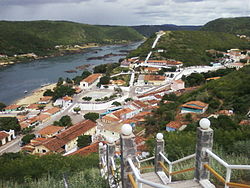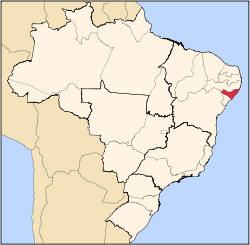Piranhas | |
|---|---|
 View of the centre of Piranhas looking upstream along the Rio São Francisco. The left-most building in the photo is a small part of the former railway station building (now a museum) and platform. | |
 Location of Piranhas in the State of Alagoas | |
| Coordinates: 09°37′26″S37°45′25″W / 9.62389°S 37.75694°W | |
| Country | Brazil |
| State | |
| Population (2020) | |
• Total | 25,183 |
| Time zone | UTC−3 (BRT) |
| Website | Official website |
Piranhas is a historic municipality near the western limit of the State of Alagoas, in the Northeast Region of Brazil.
Contents
Located on the banks of the São Francisco River, on the border with the State of Sergipe, Piranhas was founded in 1891 and originally named Floriano Peixoto (in honor of the Army General who was one of the founders of the Republic and was later elected President).
It was also known as Porto de Piranhas, because fishermen caught piranhas (a carnivorous predator fish) there.




